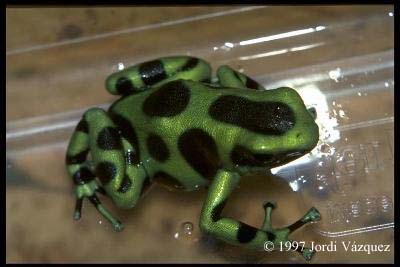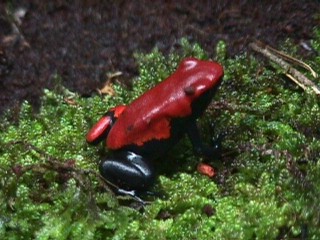Toxin Ecology
| Where is the toxin stored?
During metamorphosis many frogs including Dendrobatids develop cutaneous granular glands. These glands are widely scattered over the bodies of various frogs near the openings of the frogs mucous glands (Daly et al. 1987; Myers and Daly 1983). It appears these glands are a "convenient evolution-preadaption for the polyphyletic synthesis, storage and release of diverse toxins" (Daly et al. 1987; Neuwirth et al. 1979). In Dendrobatids it turns out these glands have become specialized for the release of the toxins discussed earlier. When threatened the frog will release the toxin to the skin surface to act as a predator defense. Interestingly, many of the frogs have modified their physiology so that their own toxins will not affect them. For example, the sodium channels in Phyllobates terriblis have been altered to prevent self intoxication (Daly et al. 1997). |
Dendrobates auratus. Photo courtesy of Jimmi Pedersen |
|
|
Photo courtesy of Jimmi Pedersen |
Where does the toxin come from? This is one of the most misunderstood of all questions concerning the physiology of toxins in Poison Dart Frogs. In recent years, researchers have begun to unlock the secrets behind toxin acquisition in these frogs. In scientific studies and observations it turned out that most captively raised Dendrobatids have an absence of alkaloid toxins or at the very least a dramatic lowering in toxin content (Daly et al. 1994; Daly et al. 2000). Growing evidence suggests that at least some toxins in the suite found in Poison Dart Frogs comes from assimilation within their food. These small frogs scour the leaf litter within their natural environment looking for a variety of arthropods including beetles, millipedes and flies. In tests where captive bred frogs fed with fruit flies were raised alongside frogs with leaf litter from their native environment only the native frogs incorporated toxins (Daly et al. 1994; Daly et al. 2000). Clearly, the leaf litter in a Dendrobatids home environment can provide some dietary sources for the numerous toxins in this group of animals. Scientists are only now beginning to realize the importance of diet and food selection as a major role in toxin development. |
|


